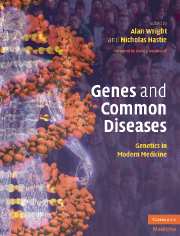Book contents
- Frontmatter
- Contents
- List of Contributors
- Foreword
- Section 1 Introductory Principles
- Section 2 Common Medical Disorders
- 13 Developmental disorders
- 14 Genes, environment and cancer
- 15 The polygenic basis of breast cancer
- 16 TP53: A master gene in normal and tumor suppression
- 17 Genetics of colorectal cancer
- 18 Genetics of autoimmune disease
- 19 Susceptibility to infectious diseases
- 20 Inflammatory bowel diseases
- 21 Genetic anemias
- 22 Genetics of chronic disease: obesity
- 23 Type 2 diabetes mellitus
- 24 Genetics of coronary heart disease
- 25 Genetics of hypertension
- 26 Obstructive pulmonary disease
- 27 Skeletal disorders
- 28 The genetics of common skin diseases
- 29 Molecular genetics of Alzheimer's disease and other adult-onset dementias
- 30 Major psychiatric disorders in adult life
- 31 Speech and language disorders
- 32 Common forms of visual handicap
- 33 Genetic and environmental influences on hearing impairment
- 34 Pharmacogenomics: clinical applications
- Index
- References
25 - Genetics of hypertension
Published online by Cambridge University Press: 17 August 2009
- Frontmatter
- Contents
- List of Contributors
- Foreword
- Section 1 Introductory Principles
- Section 2 Common Medical Disorders
- 13 Developmental disorders
- 14 Genes, environment and cancer
- 15 The polygenic basis of breast cancer
- 16 TP53: A master gene in normal and tumor suppression
- 17 Genetics of colorectal cancer
- 18 Genetics of autoimmune disease
- 19 Susceptibility to infectious diseases
- 20 Inflammatory bowel diseases
- 21 Genetic anemias
- 22 Genetics of chronic disease: obesity
- 23 Type 2 diabetes mellitus
- 24 Genetics of coronary heart disease
- 25 Genetics of hypertension
- 26 Obstructive pulmonary disease
- 27 Skeletal disorders
- 28 The genetics of common skin diseases
- 29 Molecular genetics of Alzheimer's disease and other adult-onset dementias
- 30 Major psychiatric disorders in adult life
- 31 Speech and language disorders
- 32 Common forms of visual handicap
- 33 Genetic and environmental influences on hearing impairment
- 34 Pharmacogenomics: clinical applications
- Index
- References
Summary
Introduction
Higher levels of blood pressure are a major risk factor for coronary heart disease (CHD), stroke, cardiac failure and renal failure. Meta-analysis of individual participant data from over 1 million people in prospective cohort studies has shown that the log risk of coronary heart disease and stroke are linearly related to the level of blood pressure throughout a range which extends well into that usually regarded as “normal,” with no evidence of a threshold below which blood pressure no longer influences risk (Lewington et al., 2002). Studies involving participants from many different countries show that high blood pressure is a risk for these conditions throughout the world, with the expected impact of high blood pressure set to increase as developing countries industrialise (Yusuf et al., 2004). Blood pressure is distributed approximately log-normally in all populations studied to date; within this distribution, cut-off criteria for levels of blood pressure which confer a level of risk requiring treatment (and thus define conventional hypertension) have changed over time, in general being revised downward as the importance of even relatively small elevations in blood pressure has been more widely appreciated. Currently, the European Hypertension Society guidelines define Grade I hypertension as a systolic pressure of 140–159 mmHg and/or a diastolic pressure of 90–99 mmHg; such a definition would result in some 40% of males and 33% of females in the UK carrying a diagnosis of hypertension (European Society of Hypertension/European Society of Cardiology Guidelines Committee, 2003).
- Type
- Chapter
- Information
- Genes and Common DiseasesGenetics in Modern Medicine, pp. 377 - 390Publisher: Cambridge University PressPrint publication year: 2007



